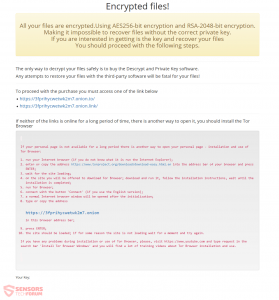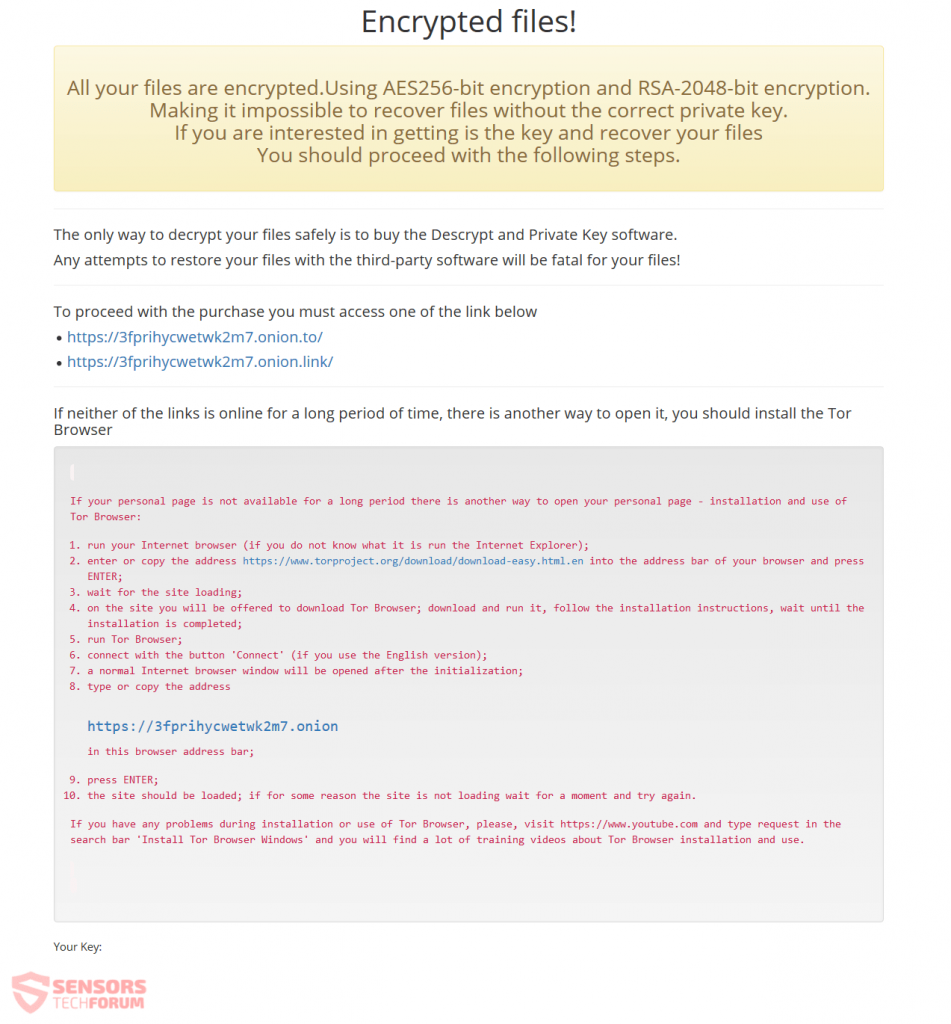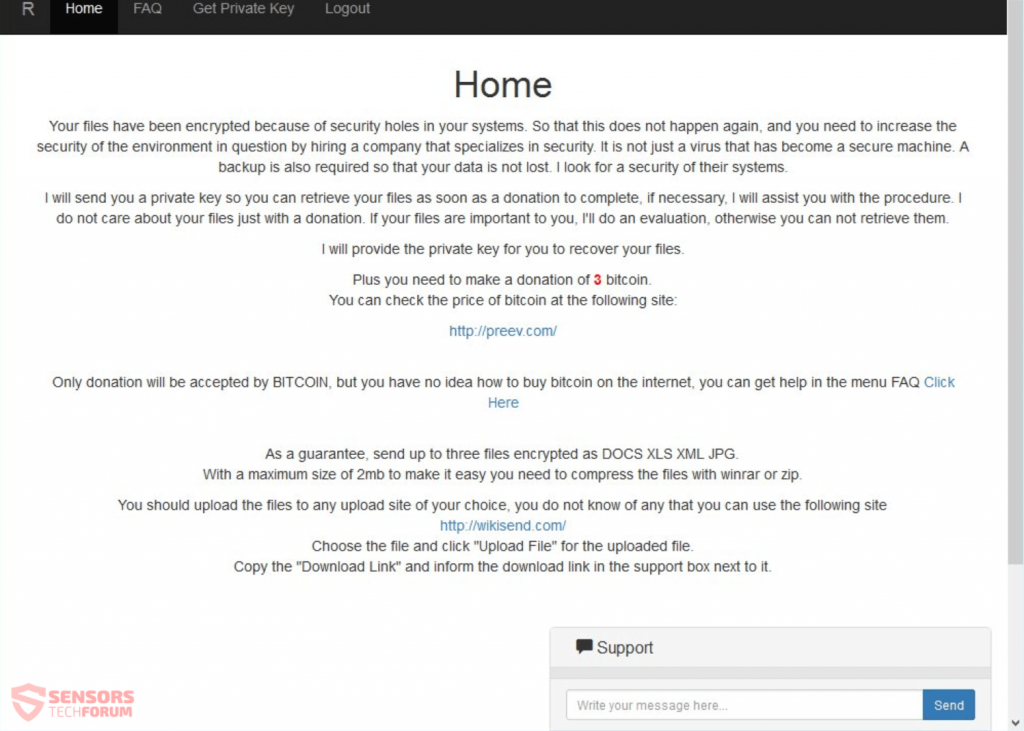 This article has been created in order to help you by explaining how to remove the .NMCRYPT file ransomware from your computer and how to restore .NMCRYPT encrypted files without having to pay ransom.
This article has been created in order to help you by explaining how to remove the .NMCRYPT file ransomware from your computer and how to restore .NMCRYPT encrypted files without having to pay ransom.
Another sub-variant of the previously detected .NM4 ransomware (Nmoreira) infection has been detected out in the wild, using the .NMCRYPT file extension. The virus is believed to be a variant of a previously known virus as the “R Cryptovirus”, which is believed to derive from the NMoreira ransomware. It is from the file encryption kind, meaning that the infection aims to encrypt the files on your computer after which set the .NMCRYPT file extension to them and asks the victim to pay a hefty ransom fee to get them to work again. If your computer has been infected by the .NMCRYPT files virus, we recommend that you read this article to learn how to cope with this infection and remove it from your PC plus try to recover your encrypted files afterwards.

Threat Summary
| Name | .NMCRYPT Files Virus |
| Type | Ransomware, Cryptovirus |
| Short Description | Encrypts the files on your computer and asks that you pay around 7000 USD in BitCoin to get your files to work again. |
| Symptoms | The .NMCRYPT files virus leaves behind it’s distinctive file extension and a ransom note, called “Recovers your files.html” which takes the victim to a TOR payment site. |
| Distribution Method | Spam Emails, Email Attachments, Executable files |
| Detection Tool |
See If Your System Has Been Affected by malware
Download
Malware Removal Tool
|
User Experience | Join Our Forum to Discuss .NMCRYPT Files Virus. |
| Data Recovery Tool | Windows Data Recovery by Stellar Phoenix Notice! This product scans your drive sectors to recover lost files and it may not recover 100% of the encrypted files, but only few of them, depending on the situation and whether or not you have reformatted your drive. |

.NMCRYPT Ransomware – How Does It Infect
The main method of infection, used by the .NMCRYPT ransomware has been reported to be via a malicious file posing as the file svchost.exe, reported in VirusTotal by malware researchers to be with the following parameters:
→ SHA-256 – e192995a42b91bd86aa0c5fe5d4e4aaff1b921bdb10946b1ea67565b5d3164da
Name – scvhost.exe
Size – 1.48 MB
The file may come as a result of multiple different types of tactics used by the criminals to result in a successful infection. They may be more aggressive methods, such as spreading the malicious file as a part of e-mail spam messages, whose primary goal is to trick you into opening the e-mail attachment, which is usually a fake Microsoft Word document or another type of file, posing as a legitimate one. These type of e-mails often pretend that they come from important companies, like PayPal, eBay, LinkedIn, Amazon, DHL, FedEx, etc. Once the victim opens the malicious attachment, it uses an infection script that extracts the malicious file on the victim’s computer. The file which may be extracted by such payload droppers is named svchost.exe and it imitates the legitimate svhost.exe process by Windows in order to evade detection.

.NTCRYPT Files Virus – Analysis
The .NTCRYPT files virus is believed to be a variant of the AiraCrop ransomware, likely the 5th iteration, since the 4th one used the extension NM4 (Nmoreira 4).
Once an infection with this virus occurs, it may start to read different information from the infected computer, such as:
- Computer’s name.
- Current registries.
- Volume shadow service’s settings.
- Current computer security settings.
The virus then obtains administrative permissions my taking control of key Windows processes as a result of injecting malicious code in them. It runs the following commands in Windows Shell as an administrator:
→ /c wevtutil cl Application” on {date and time}
/c wevtutil cl security” on {date and time}
/c wevtutil cl setup” on {date and time}
/c wevtutil cl system” on {date and time}
/c vssadmin.exe Delete Shadows \/All \/Quiet” on {date and time}
/c WMIC SERVICE WHERE ‘caption LIKE ‘%Firebird%” CALL STOPSERVICE” on {date and time}
/c WMIC SERVICE WHERE ‘caption LIKE ‘%MSSQL%” CALL STOPSERVICE” on {date and time}
/c WMIC SERVICE WHERE ‘caption LIKE ‘%SQL%” CALL STOPSERVICE” on {date and time}
/c WMIC SERVICE WHERE ‘caption LIKE ‘%Exchange%” CALL STOPSERVICE” on {date and time}
/c WMIC SERVICE WHERE ‘caption LIKE ‘%wsbex%” CALL STOPSERVICE” on {date and time}
/c WMIC SERVICE WHERE ‘caption LIKE ‘%postgresql%” CALL STOPSERVICE” on {date and time}
/c WMIC SERVICE WHERE ‘caption LIKE ‘%BACKP%” CALL STOPSERVICE” on {date and time}
/c WMIC SERVICE WHERE ‘caption LIKE ‘%tomcat%” CALL STOPSERVICE” on {date and time}
As soon as this is done, the ransomware opens the following services in a control manager
- sc.exe
- net1.exe
Then, the .NMCRYPT ransomware spawns the following Windows processes:
- cmd.exe
- wevtutil.exe
The virus manipulates those processes by injecting the following types of scripted commands within them:
→ /c wevtutil cl Application
/c wevtutil cl security
/c wevtutil cl setup
/c wevtutil cl system
These commands are likely a prerequisite to what the .NMCRYPT ransomware does next, which is to drop it’s malicious payload on the victim’s computer. The payload files are colled as follows:
- ProPlusWW.xml.NMCRYPT
- pkeyconfig-office.xrm-ms.NMCRYPT
- OWOW32WW.cab.NMCRYPT
- ProPsWW.cab.NMCRYPT
- Office32WW.xml.NMCRYPT
- ProPsWW2.cab.NMCRYPT
The files, which pretend to be legitimate Microsoft office data files, are actually the malicious modules of the ransomware. As soon as this is done, the ransomware may touch key files within the Windows’s system directory, in order to change settings of Windows by modifying their structure. The files touched by this infection are reported to be the following:
→ %Windows%\SysWOW64\rsaenh.dll”
%Windows%\Globalization\Sorting\SortDefault.nls
%Windows%\AppPatch\sysmain.sdb
%Windows%\SysWOW64\cmd.exe
%Windows%\Globalization\Sorting\SortDefault.nls”
%Windows%\AppPatch\sysmain.sdb”
%Windows%\SysWOW64\wevtutil.exe”
%Windows%\SysWOW64\en-US\wevtutil.exe.mui”
%Windows%\Globalization\Sorting\SortDefault.nls”
The virus then begins to use the WMIC.exe process for remote access-related activities. It does this by taking advantage of the process, to read the following running services and processes:
- Firebird
- MSSQL
- SQL
- Exchange
- Wsbeex
- Posgresql
- Backup
- Tomcat
- SharePoint
- SBS
If the .NMCRYPT ransomware detects those processes, the virus immediately stops them from running, by using the WMIC.exe with the command “WMIC SERVICE WHERE {NAME} CALL STOPSERVICE”.
The malware does not stop there and it then corrupts the vssadin.exe file in order to delete the shadow volume copies of the infected computer by directly modifying it with the following bytes written directly into the .exe:
→ 7111d9017a3bd801ab8b02007f950200fc8c0200729602006cc805001ecdd5017d26d501
When the virus finishes this, it also drops it’s ransom note file, which is named “Recovers your files.html” and looks like the following image:

The creators of this virus instruct the victim within the ransom note to visit a login page where after they have entered their unique key, they may enter only to see more instructions on how to pay an extremely large sum of money to get their files back:

The difference with the older version of the virus, is that now the crooks want more money (around 7000 USD), suggesting that the virus may target institutions, like government or private organizations’ facilities. And to further stress the importance of paying, they have even added support for the victim via live chat, where they do not reply immediately, but after several hours of writing to them.

.NMCRYPT Ransomware – How Does It Encrypt
The .NMRCRYPT ransomware is believed to scan for the most widely used types of files, like documents, videos, images, audio files and even database files and archives. The ransomware DOES NOT attack files that belong to Windows and also files that have the following file extensions:
→ .bat, .dll, .exe, .ini, .lnk, .msi, .scf
The .NMCRYPT files virus also excludes the following folders or files from encryption:
AppData AVAST Software AVG AVIRA Atheros CONFIG.SYS ESET HakunaMatata IO.SYS MSDOS.SYS NTUSER.DAT NTDETECT.COM Atheros Realtek Recovers files yako.html Recovers your files.html TeamViewer Winrar lntemet Explorer Chrome Firefox Opera Windows boot bootmgr java
The .NMCRYPT ransomware is believed to use the strongest combination of encryption algorithms to encipher files, known as RSA (Rivest-Shamir-Adleman) and AES (Advanced Encryption Standard), where the virus uses AES to encrypt the files, resulting in an asymmetric key being generated and the malware also uses the RSA cipher to encode the AES decryption keys. After the encryption has finished, the files appear like the following:

Remove .NMCRYPT Files Virus and Try Restoring Your Data
In order to remove this ransomware infection from your computer, it is advisable to follow the removal instructions underneath this article. They have been created with the primary purpose to help you delete the malicious files and objects of this malware either manually or automatically, based on what you prefer doing. Be advised that an advanced anti-malware tool is recommended for automatic removal by security researchers as the more effective method which will not only remove this virus, but will also completely secure your computer in the future too.
If you want to restore files that have been encrypted by this version of NMoreira ransomware, we advise you to follow the alternative file recovery steps underneath this article In step “2. Restore files, encrypted by .NMCRYPT Files Virus”. They may not be 100% solution to your problem, but may help you to recover as many files as possible.
- Step 1
- Step 2
- Step 3
- Step 4
- Step 5
Step 1: Scan for .NMCRYPT Files Virus with SpyHunter Anti-Malware Tool



Ransomware Automatic Removal - Video Guide
Step 2: Uninstall .NMCRYPT Files Virus and related malware from Windows
Here is a method in few easy steps that should be able to uninstall most programs. No matter if you are using Windows 10, 8, 7, Vista or XP, those steps will get the job done. Dragging the program or its folder to the recycle bin can be a very bad decision. If you do that, bits and pieces of the program are left behind, and that can lead to unstable work of your PC, errors with the file type associations and other unpleasant activities. The proper way to get a program off your computer is to Uninstall it. To do that:


 Follow the instructions above and you will successfully delete most unwanted and malicious programs.
Follow the instructions above and you will successfully delete most unwanted and malicious programs.
Step 3: Clean any registries, created by .NMCRYPT Files Virus on your computer.
The usually targeted registries of Windows machines are the following:
- HKEY_LOCAL_MACHINE\Software\Microsoft\Windows\CurrentVersion\Run
- HKEY_CURRENT_USER\Software\Microsoft\Windows\CurrentVersion\Run
- HKEY_LOCAL_MACHINE\Software\Microsoft\Windows\CurrentVersion\RunOnce
- HKEY_CURRENT_USER\Software\Microsoft\Windows\CurrentVersion\RunOnce
You can access them by opening the Windows registry editor and deleting any values, created by .NMCRYPT Files Virus there. This can happen by following the steps underneath:


 Tip: To find a virus-created value, you can right-click on it and click "Modify" to see which file it is set to run. If this is the virus file location, remove the value.
Tip: To find a virus-created value, you can right-click on it and click "Modify" to see which file it is set to run. If this is the virus file location, remove the value.
Before starting "Step 4", please boot back into Normal mode, in case you are currently in Safe Mode.
This will enable you to install and use SpyHunter 5 successfully.
Step 4: Boot Your PC In Safe Mode to isolate and remove .NMCRYPT Files Virus





Step 5: Try to Restore Files Encrypted by .NMCRYPT Files Virus.
Method 1: Use STOP Decrypter by Emsisoft.
Not all variants of this ransomware can be decrypted for free, but we have added the decryptor used by researchers that is often updated with the variants which become eventually decrypted. You can try and decrypt your files using the instructions below, but if they do not work, then unfortunately your variant of the ransomware virus is not decryptable.
Follow the instructions below to use the Emsisoft decrypter and decrypt your files for free. You can download the Emsisoft decryption tool linked here and then follow the steps provided below:
1 Right-click on the decrypter and click on Run as Administrator as shown below:

2. Agree with the license terms:

3. Click on "Add Folder" and then add the folders where you want files decrypted as shown underneath:

4. Click on "Decrypt" and wait for your files to be decoded.

Note: Credit for the decryptor goes to Emsisoft researchers who have made the breakthrough with this virus.
Method 2: Use data recovery software
Ransomware infections and .NMCRYPT Files Virus aim to encrypt your files using an encryption algorithm which may be very difficult to decrypt. This is why we have suggested a data recovery method that may help you go around direct decryption and try to restore your files. Bear in mind that this method may not be 100% effective but may also help you a little or a lot in different situations.
Simply click on the link and on the website menus on the top, choose Data Recovery - Data Recovery Wizard for Windows or Mac (depending on your OS), and then download and run the tool.
.NMCRYPT Files Virus-FAQ
What is .NMCRYPT Files Virus Ransomware?
.NMCRYPT Files Virus is a ransomware infection - the malicious software that enters your computer silently and blocks either access to the computer itself or encrypt your files.
Many ransomware viruses use sophisticated encryption algorithms to make your files inaccessible. The goal of ransomware infections is to demand that you pay a ransom payment to get access to your files back.
What Does .NMCRYPT Files Virus Ransomware Do?
Ransomware in general is a malicious software that is designed to block access to your computer or files until a ransom is paid.
Ransomware viruses can also damage your system, corrupt data and delete files, resulting in the permanent loss of important files.
How Does .NMCRYPT Files Virus Infect?
Via several ways..NMCRYPT Files Virus Ransomware infects computers by being sent via phishing emails, containing virus attachment. This attachment is usually masked as an important document, like an invoice, bank document or even a plane ticket and it looks very convincing to users.
Another way you may become a victim of .NMCRYPT Files Virus is if you download a fake installer, crack or patch from a low reputation website or if you click on a virus link. Many users report getting a ransomware infection by downloading torrents.
How to Open ..NMCRYPT Files Virus files?
You can't without a decryptor. At this point, the ..NMCRYPT Files Virus files are encrypted. You can only open them once they are decrypted using a specific decryption key for the particular algorithm.
What to Do If a Decryptor Does Not Work?
Do not panic, and backup the files. If a decryptor did not decrypt your ..NMCRYPT Files Virus files successfully, then do not despair, because this virus is still new.
Can I Restore "..NMCRYPT Files Virus" Files?
Yes, sometimes files can be restored. We have suggested several file recovery methods that could work if you want to restore ..NMCRYPT Files Virus files.
These methods are in no way 100% guaranteed that you will be able to get your files back. But if you have a backup, your chances of success are much greater.
How To Get Rid of .NMCRYPT Files Virus Virus?
The safest way and the most efficient one for the removal of this ransomware infection is the use a professional anti-malware program.
It will scan for and locate .NMCRYPT Files Virus ransomware and then remove it without causing any additional harm to your important ..NMCRYPT Files Virus files.
Can I Report Ransomware to Authorities?
In case your computer got infected with a ransomware infection, you can report it to the local Police departments. It can help authorities worldwide track and determine the perpetrators behind the virus that has infected your computer.
Below, we have prepared a list with government websites, where you can file a report in case you are a victim of a cybercrime:
Cyber-security authorities, responsible for handling ransomware attack reports in different regions all over the world:
Germany - Offizielles Portal der deutschen Polizei
United States - IC3 Internet Crime Complaint Centre
United Kingdom - Action Fraud Police
France - Ministère de l'Intérieur
Italy - Polizia Di Stato
Spain - Policía Nacional
Netherlands - Politie
Poland - Policja
Portugal - Polícia Judiciária
Greece - Cyber Crime Unit (Hellenic Police)
India - Mumbai Police - CyberCrime Investigation Cell
Australia - Australian High Tech Crime Center
Reports may be responded to in different timeframes, depending on your local authorities.
Can You Stop Ransomware from Encrypting Your Files?
Yes, you can prevent ransomware. The best way to do this is to ensure your computer system is updated with the latest security patches, use a reputable anti-malware program and firewall, backup your important files frequently, and avoid clicking on malicious links or downloading unknown files.
Can .NMCRYPT Files Virus Ransomware Steal Your Data?
Yes, in most cases ransomware will steal your information. It is a form of malware that steals data from a user's computer, encrypts it, and then demands a ransom in order to decrypt it.
In many cases, the malware authors or attackers will threaten to delete the data or publish it online unless the ransom is paid.
Can Ransomware Infect WiFi?
Yes, ransomware can infect WiFi networks, as malicious actors can use it to gain control of the network, steal confidential data, and lock out users. If a ransomware attack is successful, it could lead to a loss of service and/or data, and in some cases, financial losses.
Should I Pay Ransomware?
No, you should not pay ransomware extortionists. Paying them only encourages criminals and does not guarantee that the files or data will be restored. The better approach is to have a secure backup of important data and be vigilant about security in the first place.
What Happens If I Don't Pay Ransom?
If you don't pay the ransom, the hackers may still have access to your computer, data, or files and may continue to threaten to expose or delete them, or even use them to commit cybercrimes. In some cases, they may even continue to demand additional ransom payments.
Can a Ransomware Attack Be Detected?
Yes, ransomware can be detected. Anti-malware software and other advanced security tools can detect ransomware and alert the user when it is present on a machine.
It is important to stay up-to-date on the latest security measures and to keep security software updated to ensure ransomware can be detected and prevented.
Do Ransomware Criminals Get Caught?
Yes, ransomware criminals do get caught. Law enforcement agencies, such as the FBI, Interpol and others have been successful in tracking down and prosecuting ransomware criminals in the US and other countries. As ransomware threats continue to increase, so does the enforcement activity.
About the .NMCRYPT Files Virus Research
The content we publish on SensorsTechForum.com, this .NMCRYPT Files Virus how-to removal guide included, is the outcome of extensive research, hard work and our team’s devotion to help you remove the specific malware and restore your encrypted files.
How did we conduct the research on this ransomware?
Our research is based on an independent investigation. We are in contact with independent security researchers, and as such, we receive daily updates on the latest malware and ransomware definitions.
Furthermore, the research behind the .NMCRYPT Files Virus ransomware threat is backed with VirusTotal and the NoMoreRansom project.
To better understand the ransomware threat, please refer to the following articles which provide knowledgeable details.
As a site that has been dedicated to providing free removal instructions for ransomware and malware since 2014, SensorsTechForum’s recommendation is to only pay attention to trustworthy sources.
How to recognize trustworthy sources:
- Always check "About Us" web page.
- Profile of the content creator.
- Make sure that real people are behind the site and not fake names and profiles.
- Verify Facebook, LinkedIn and Twitter personal profiles.













